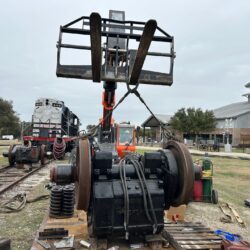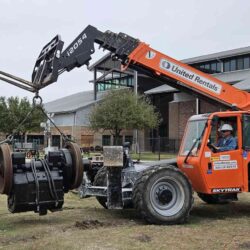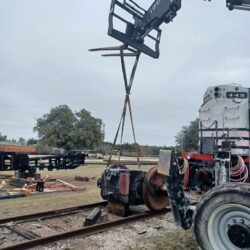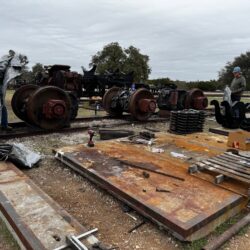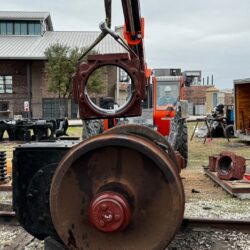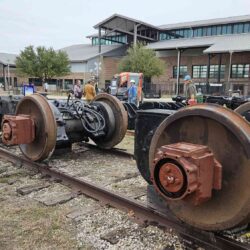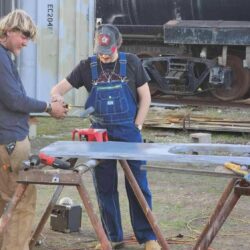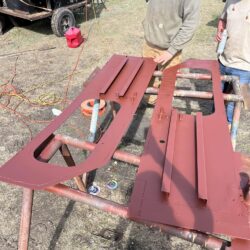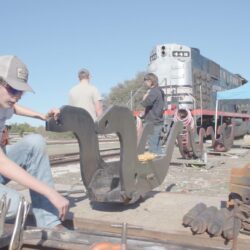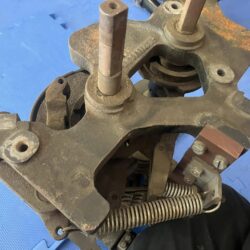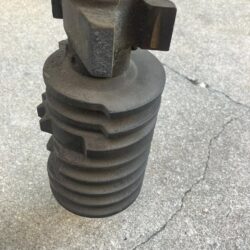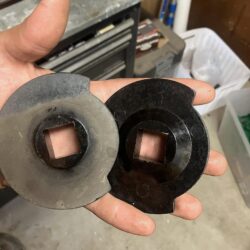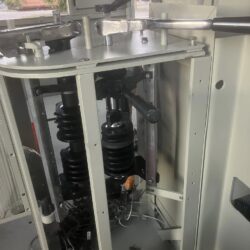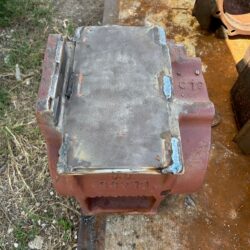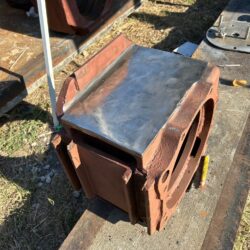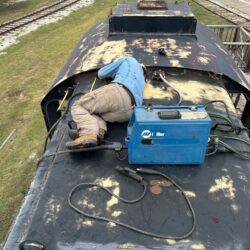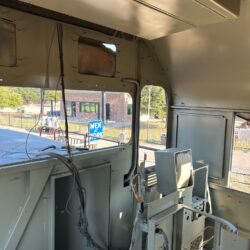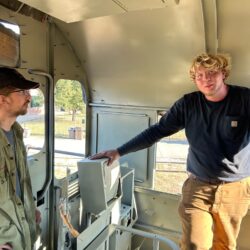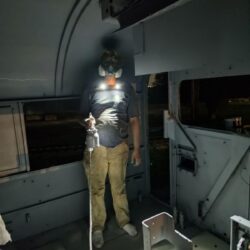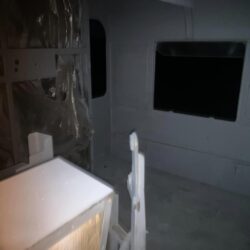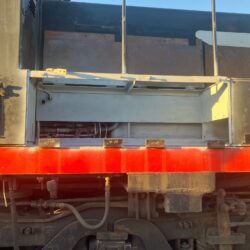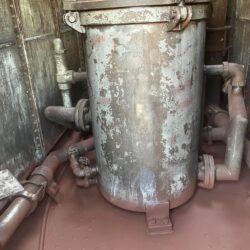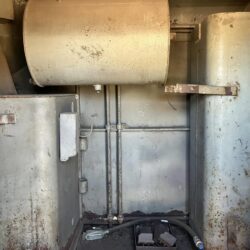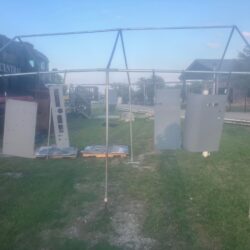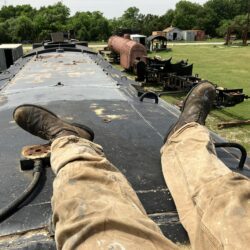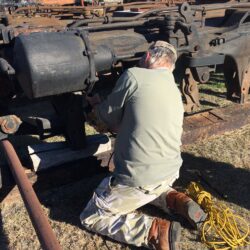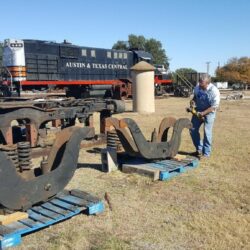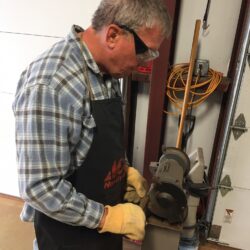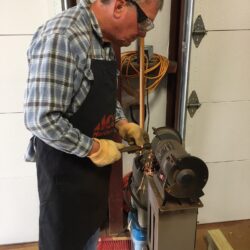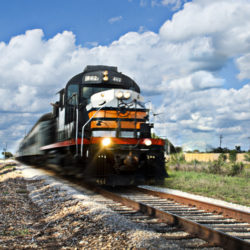Welcome to the restoration page for Diesel Locomotive #442. As the diesel workhorse in our fleet, we look forward to sharing history and updates!
History
When the Austin Steam Train Association found itself without a serviceable steam locomotive in July of 1999 we looked to diesel-electric locomotives to continue uninterrupted service. At first, borrowed engines from the local freight carrier sufficed, but a decision was made in 2000 to purchase our own diesel. That process culminated in the acquisition of engine 442.
Built by the same company that built our steam locomotive, 786, in 1916, the American Locomotive Company constructed a series of these six-axle RSD-15 road-switchers in 1960 for the Atchison, Topeka & Santa Fe Railway. Our 442 was built as Santa Fe 842, and was later renumbered 9842. The RSD-15s saw service in all parts of the Santa Fe system, and were gradually retired in the ’70s as the Santa Fe modernized its motive power fleet.
The 9842 was purchased secondhand by the Squaw Creek Coal Company of Indiana and was used to haul heavy coal trains. Our engine later wound up under the care of the Indiana Hi-Rail Corp., where it was again renumbered 442. We purchased the 442 from Indiana Hi-Rail in early 2000. ASTA staff and volunteers rebuilt the 442 for regular service and painted the engine in a modified Southern Pacific “Black Widow” paint scheme. The 2,400-horsepower locomotive is the last known operating example of its class. The Alco RSD-15s are more commonly known to railroad enthusiasts as “alligators” in reference to the locomotives’ long, low noses.
Locomotive 442 went out of service in December 2016 and is now in active restoration.
Restoration Update 2/28/2025
Rear Truck Rebuild Update:
As promised, here’s the latest on the rear truck rebuild saga! We are pleased to report that all new wear plates have been securely welded to the bearing boxes for the rear truck of 442, marking a major milestone in the project. With this step complete, we are now ready to begin the final assembly process. The next phase involves lifting all three ‘combos’—each consisting of a traction motor and axle and weighing approximately 11,000 pounds—from their repair pad onto the rails of the 442 Repair Track. Once in place, they are carefully positioned for the next critical step: lowering the rebuilt truck frame onto them. With the wheel sets firmly on the rails, the fully reconditioned bearing boxes are then lifted and aligned with the roller bearings of each axle. Success! The next step will involve a boom truck crane to fine-tune axle spacing, lift the equalizers and springs, and ultimately reunite the frame with the wheel sets and traction motors. A huge thank you to our dedicated volunteers and locomotive contractor for their hard work in keeping this project moving forward. Stay tuned for the next update!
Restoration Update 2/24/2025
Good News from the 442 Junior Crew! Lately, we’ve been fortunate to welcome an abundance of new volunteers to the 442 project. In just the past two weeks, at least ten individuals came out over four days to lend a hand, making incredible progress together. During that time, we cut the pedestal adapter shims for the rear truck, cleaned, primed, and rehung both cab door plates, and repaired the deadbolt on the front door. We also patched the rusted gap in the front door’s outer plate, straightened the warped backdoor inner piece, and fabricated and installed a new skeleton for the back cab door. In addition, we reorganized the storage container and improved shelving, ground the slag off the top of all four equalizing beams, cleaned rust from the spring supports, welded a pipe bracket back into place on the rear truck, and began repairs on both broken slack adjusters. Looking ahead, we plan to apply another coat of paint to all truck parts before reassembly and finish welding on the doors this coming weekend. A huge thank you to everyone who has pitched in—we couldn’t do it without you!
Restoration Update 12/21/2024
Dr. Robert Schoen, board president of the Austin Steam Train Association, gives an update on returning our RSD-15, the 442, to operation.
Restoration Update 11/21/2024
Noah reinstalled most of the controller in the cab. Here’s some before and after photos:
Restoration Update 10/2/2024
We’re excited to share that our 442 project is gaining momentum! Steel wear plates have been welded onto the rear truck bearing boxes, and the cab roof and back wall gap have been expertly repaired by Abe Doss. Additionally, Noah Jarrett has given the cab interior a fresh, professional coat of paint. Next on the agenda is completing the wear plates on the remaining rear truck bearing boxes, reassembling the rear truck, and lifting the locomotive to install the truck underneath. Great progress is being made, so stay tuned for more updates!
Restoration Update 8/6/2024
Noah, George, John and Daniel got the first full coat of primer done on the cab! Big day!
Restoration Update 6/6/2024
Noah, and the 442 team have been working steadily on the locomotive! Here are some updates:
Restoration Update 7/18/2022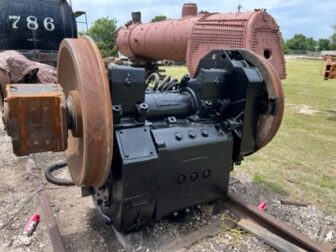
We are thrilled to share some important 442 updates! We have hired Danny Martin to speed up the progress on this important piece of history, and major improvements are now visible. Danny started with work on the journal boxes, equalizers, equalizer adapters, center bowl and load post, and traction motors #4 and #6. Following that work Danny then repaired the pedestal liners, repaired and painted the #2 truck, and replaced traction motor #5.
Check out the full presentation with photos and details here: ATCX 442 Repair Update.
Restoration Update 1/1/2021
Parts to rebuild the trucks on 442 are finally on the way, so it was time to prep the frame. Abrasive flapper wheels cleaned the machined surfaces of the pedestal jaws, and a light coat of primer was applied. The equalizer/spring seat assemblies were righted, and the worn portions of the equalizer ends – built back up to spec by weldment – were cleaned and primed as well. The 24 grade 8 bolts that fastened the liners to the jaws were renewed by wire wheeling off the corrosion, re-profiling the peened over threads with a triangular file, and finally chasing the threads with a die. That saved us a few bucks right there!
Once the new liners get installed, critical measurements can be made across the jaws to allow us to order the correct thickness of wear plate steel for the bearing boxes and have them cut and milled to tolerance.
Restoration Update 6/5/2020
Phase 1 of the restoration, which included a complete rebuild of the turbocharger and fuel injection system is complete. A variety of fuel, water, and lubricating oil leak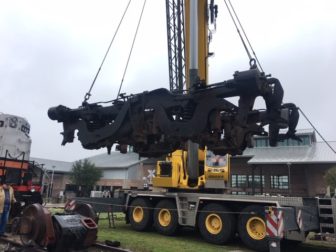 s have been repaired. The engine block has been cleaned and the inspection ports re-sealed, and the fuel rack components cleaned and lubricated for operation.
s have been repaired. The engine block has been cleaned and the inspection ports re-sealed, and the fuel rack components cleaned and lubricated for operation.
Now in Phase 2, the focus is on truck rebuild, traction motor clean-up or replacement, and normalizing wheel diameters.
With fresh funding from our end of the year fundraising dinner, we started with a Crocker Crane lift and removal of the rear truck, with complete disassembly, on a cold and wet February day, under the supervision of Harold Schroeder and his crew from San Antonio.
The truck frame was steam cleaned, old pedestal liners were removed, and the castings, springs, and foundation brake gear were inspected, and found to be in good shape.
Significant metallic wear on the ends of the equalizers were noted (no surprise) and are now being built back up to ALCO specs, by accomplished welders Chris Hoff (ASTA General Superintendent) and Abe Doss of Doss Metals.
Old traction motor blower boots were removed, but what was not anticipated was a significant buildup of grit and oil in the plenums that go from the traction motor blowers to the motors themselves, via the boots. This had been accumulating for decades, given the lack of design for blower air filtration, and breaches of the plenums by various piping. Despite the very limited access, the plenums were debrided and cleaned by our fearless mechanical department volunteers and staff.
A plan is in place to improve filtration and seal the breaches.
Next up will be a traction motor replacement with one we have in stock, followed by a turning down of wheel diameters on axles 4, 5, and 6, back to matching specifications.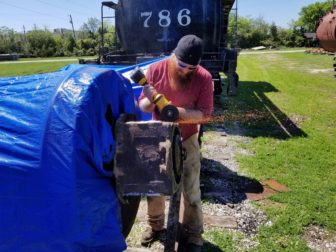
We are ordering new pedestal liners and shocks, and laser cut wear plates for both sides of all the bearing boxes that will need to be custom milled for each pedestal jaw width, then welded to the boxes.
Then we get to put the truck back together, and back under the locomotive!
And then we get to do it again on the front truck!
This is why we have always said that this phase will be the costliest, and most labor intensive of the entire rebuild of ATCX 442. But despite these expected and unexpected challenges, we are exceptionally pleased with the dedication and work ethic of our staff and volunteers as they put in the hours and days to restore this historic locomotive back to prime operating condition on the Austin & Texas Central Railroad.
We need your help!
The 442 is well on its way to joining the ASTA fleet, with just a few more dollars (and a little elbow grease), we can put this locomotive on track!
To donate to our Historic Car Restoration Fund, please click HERE.
To volunteer on our restoration team, please email us at volunteers@austinsteamtrain.org
Our supporters
This restoration project is partially funded by a grant through the The John H. Emery Rail Heritage Trust. Thank you for your support!

442 Photos

